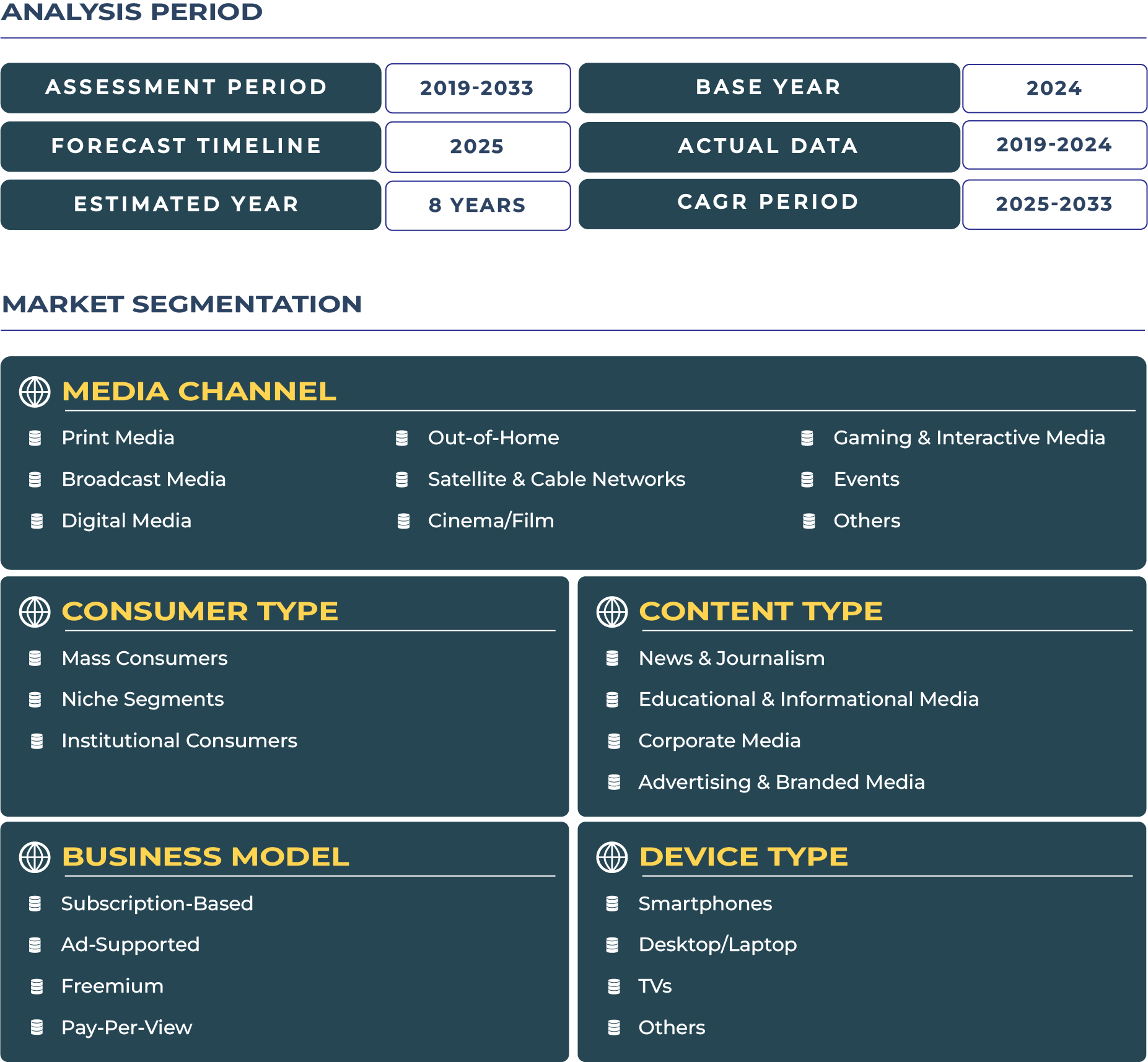Philippines Media Market Outlook
Economic Momentum and a Digital-First Population Drive Media Market Expansion
The media industry in the Philippines is undergoing a dynamic transformation, driven by a blend of digital innovation, rising consumer spending, and evolving media consumption habits. With a steadily increasing GDP per capita—estimated at US$ 4,420 in 2024—and a burgeoning middle class, Filipino consumers are spending more on digital subscriptions, smartphones, and entertainment services. Disposable income growth is accelerating demand for both local and international content. At the same time, advertising spend is forecasted to cross US$ XX billion by 2033, with digital ads expected to command over 60% of the total media spend. From 2025 to 2033, the industry is poised for a CAGR of XX.8% (2025–2033), led by online platforms, content personalization, and mobile-first user behavior.
Media Consumption Reflects Youthful Demographics and Digital Ubiquity
A defining trait of the Filipino media market is its young, tech-savvy population. Over 60% of the population is under 30, and internet penetration reached 73.5% in 2024. Mobile-first usage is dominant, with Filipinos spending an average of 9.3 hours online daily—the highest in Southeast Asia. Social media, online streaming, mobile gaming, and bite-sized video platforms like TikTok and YouTube dominate entertainment consumption. This shift is gradually replacing traditional media such as terrestrial TV and print. Gen Z and Millennials favor hyperlocal digital content, meme culture, influencer-driven news, and regional language storytelling, pushing media brands to innovate in content format and delivery.
Media Channels Transforming Through Digital Evolution
The Philippines media ecosystem is evolving rapidly across channels—television, digital, radio, and print. ABS-CBN, once the country's largest broadcast network, lost its franchise renewal in 2020 but pivoted successfully into digital content delivery, OTT partnerships (iWantTFC), and collaborations with Netflix and YouTube. In 2023, ABS-CBN launched Senior High, a youth-focused drama that became a YouTube hit with over 200 million views in four months. Meanwhile, GMA Network has embraced digital monetization via GMA Now (a mobile digital TV stick) and the Kapuso Stream, targeting hybrid viewers who toggle between free-to-air and mobile access.
On-demand and OTT platforms such as Netflix, Viu, Vivamax, and Amazon Prime Video are expanding footprints through regional content, Filipino subtitles, and bundling with telecom operators like Globe and Smart. Radio remains relevant in rural areas and during calamities, but digital platforms have begun integrating live FM with streaming options. Print media, including Philippine Daily Inquirer and Manila Bulletin, are focusing on digital journalism, AI-generated news summaries, and membership-based access.
Content Consumption Habits: Mobile, Social, and Snackable
Filipinos are social-first consumers—Facebook, TikTok, and YouTube are primary content platforms, not just social networks. Content formats that thrive include short skits, commentary, karaoke challenges, true crime, and community-based vlogs. Mobile data affordability and partnerships between telcos and media firms are accelerating content reach. For example, Smart’s GigaPlay app provides exclusive access to live concerts, sports, and original shows as part of prepaid bundles. Music streaming and podcasts, too, are on the rise, with Spotify Philippines recording over 3 billion streams in 2023 alone, bolstered by local artists and original podcast series.
Binge-watching culture is also prevalent, especially for Korean dramas, Filipino teleseryes, and reality content. Weekend surges in streaming are now shaping the release schedules of major OTT platforms. Personalization through AI, localized recommendations, and cross-device syncing are becoming key user experience differentiators.
Leading Brands and Subscriber Dynamics in a Competitive Landscape
GMA Network leads the traditional broadcast race, while ABS-CBN dominates the digital content space. As of 2024, ABS-CBN’s YouTube channel has over 45 million subscribers, making it one of the top 5 most-subscribed media channels globally. Viva Communications has doubled down on paid streaming via Vivamax, with over 6 million subscribers, targeting mature audiences with bold, local films. Netflix Philippines continues to grow, with over 4 million subscribers and a stronghold in urban areas. Meanwhile, local creators like Toni Gonzaga Studios and Cong TV have amassed millions of followers, competing head-to-head with major media houses.
International platforms use aggressive pricing, free trials, and local partnerships to grow. Disney+ launched in the Philippines in 2022 and quickly captured market share through tie-ups with Globe Telecom and bundling with family plans. YouTube Premium and Spotify Family have gained traction due to ad fatigue and multi-user preferences.
Customer Acquisition Strategies: Telco Bundles, Micropricing, and Creator Ecosystems
Go-to-market strategies in the Philippines media market increasingly focus on affordability, accessibility, and personalization. Telecom bundling is the most effective customer acquisition strategy—Netflix, Viu, and Vivamax are often packaged with prepaid or fiber plans. Micropricing, such as PHP 10/day video streaming passes, has democratized access to content. Media firms also rely heavily on creators and influencers for organic reach. ABS-CBN and GMA collaborate with TikTok stars and YouTubers for co-branded content, driving younger viewership.
Media brands are also experimenting with loyalty-based engagement. GMA’s Kapuso VIP and Vivamax’s point-based referral programs reward binge-watching, social sharing, and feedback submissions. AI-based recommendation engines and interactive content polls are enhancing user retention. With evolving preferences and greater digital infrastructure, the Philippines media market is set to become a regional leader in content innovation and creator-driven ecosystems.
Author
Author: Joseph Gomes Y (Head – Media and Entertainment)
*Research Methodology: This report is based on DataCube’s proprietary 3-stage forecasting model, combining primary research, secondary data triangulation, and expert validation. [Learn more]
Philippines Media Market Segmentation







